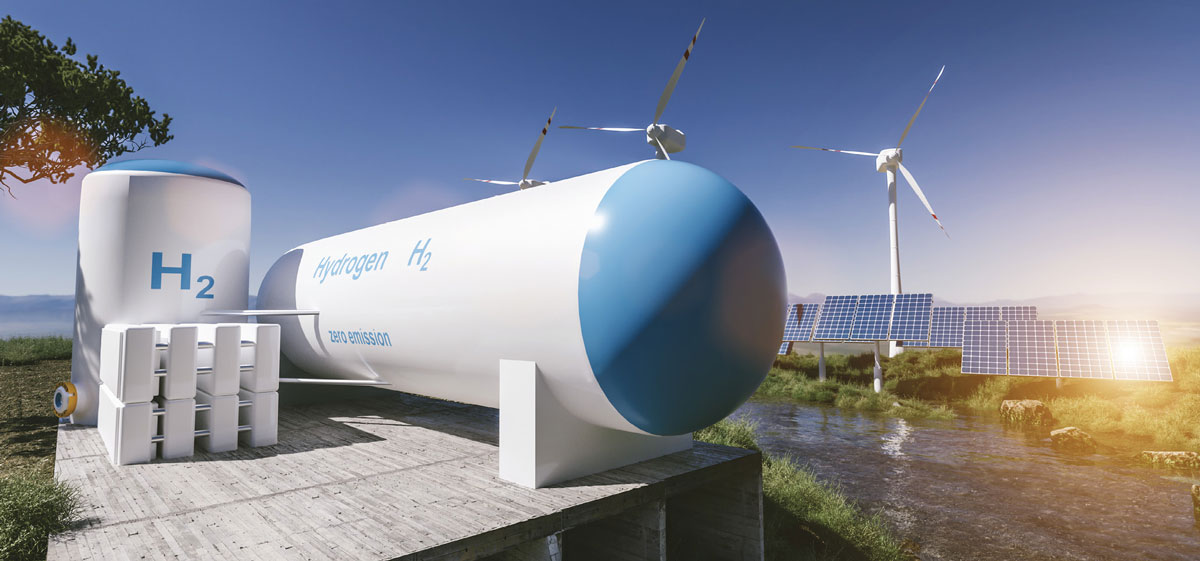FST JOURNAL
Hydrogen and Net Zero
DOI: https://www.doi.org/10.53289/WVCK7991
A game-changer for the energy economy
Nigel Topping

Nigel Topping is the COP26 High-Level Climate Action Champion, appointed by the UK Prime Minister in January 2020. The role of the high-level champions is to strengthen collaboration and drive action from businesses, investors, organisations, cities, and regions on climate change, and coordinate this work with governments and parties to the United Nations Framework Convention on Climate Change (UNFCCC). Nigel was most recently CEO of We Mean Business, a coalition of businesses working to accelerate the transition to a zero-carbon economy.
The UK finds itself in the middle of a pandemic at a time when the world has never been so connected. The scientific and research advances that we have seen, together with the leaps in recent decades, have allowed us to communicate far better than we could have otherwise.
My current role is to build ambition and confidence about the pathways to net zero. An increasing number of actors across the whole value chain are coming together and – pre-competitively – agreeing what the next steps are. Green hydrogen is a prime example of this, but it is still at a very early stage.
The Energy Transitions Commission, which is chaired by Adair Turner and Ajay Mathur, published a report called Mission Possible1 in 2018. This looked at how we tackle all the hard-to-abate sectors – cement, steel, plastics, aluminium, shipping, aviation and long-distance trucking. Most of the Commissioners are CEOs of energy producers or energy-intensive companies.
Through the year that we were commissioning research and reviewing the findings, there was a dawning awareness of the importance of hydrogen in the future energy economy. Electrification will provide direct efficiency benefits and renewable electricity generation will reduce emissions. Yet there are some applications for which either the volumetric or the energy density requirement, or required chemical reactions, mean that renewable electricity will find it difficult to get the decarbonisation job done. Because of that, steel producers from Sweden to Chile are turning to hydrogen, and companies such as Volvo and Daimler are betting on long-distance trucking with fuel cell technology. Airbus is exploring new concepts for hydrogen planes to take off in 2035. Others, though, believe that battery technology could also work here.
A different business model
Hydrogen, as a gas, presents an alternative business model for innovation by oil and gas companies, with both producers and infrastructure players looking at ways to navigate the path to net zero. There is a good place to start: today, fossil hydrogen production, chiefly from natural gas, amounts to 3-4% of total global emissions. People who have been around in the industry for some time caution that this is the third birth of a low-carbon hydrogen economy, so one has to be a little guarded about the latest announcements. Nevertheless, in the past few years there have been many gigawatts of projects and public sector targets announced for green hydrogen by 2030.
The UK’s Business Secretary Kwasi Kwarteng is an enthusiastic advocate and the Government is preparing its own domestic hydrogen strategy.
It is really important to look at both the supply side and the demand side – if all the attention is on the supply side but there is not sufficient demand pull, then the process will come to a stuttering halt. While fossil hydrogen with carbon capture and storage seems a convenient way to decarbonise current gas use, it first has to overcome a critical issue: methane leakage that amounts to 16% of man-made emissions today. Some countries, like Australia and China, are entertaining the idea of hydrogen production from coal. In most countries, though, it appears that renewable hydrogen (i.e. produced by electrolysis or renewable energy) is going to be the winner, economically, by 2030.
One of the most exciting recent developments has been the launch of the Green Hydrogen Catapult. Seven major energy players and Yara (one of the biggest fertiliser producers in the world) have developed a programme to deploy 25GW capacity within the next five years. Our assessment suggests a price level of $2 per kg by that time. Green hydrogen will then be cost-competitive with fossil fuels that have carbon capture attached, at which stage real scaling-up can start.
 Major corporations have developed a programme to deploy 25GW of hydrogen derived capacity within the next five years [SHUTTERSTOCK/ALEXANDER KIRCH].
Major corporations have developed a programme to deploy 25GW of hydrogen derived capacity within the next five years [SHUTTERSTOCK/ALEXANDER KIRCH].
A systems approach
That is going to take a whole system effort on the supply side, but then there has to be a similar demand-side effort based on clusters around shipping, aviation, trucking, steel, etc. There are global, governmental initiatives such as Mission Innovation and the Clean Energy Ministerial as well as mission-driven private sector approaches like the Green Hydrogen Catapult. With all the stars aligning, this could stimulate really rapid development – and by bringing the costs down, the price signal should drive demand up.
Hydrogen also has the potential to change the geopolitics of energy. Countries like Australia, South Africa, Chile and India – with very large land areas and an abundance of sun – are all saying that this could be a game-changing opportunity, allowing them to export clean energy. This could be a new business, for Chile for example, or a replacement for a dying coal business, as in South Africa and Australia. The hydrogen economy will need to grow by a factor of 7-10 times by 2050 in order to get to net zero. If the vast majority of that will be green hydrogen, as expected by the Energy Transitions Commission, that will make this one of the most exciting areas for technological and economic transition.
